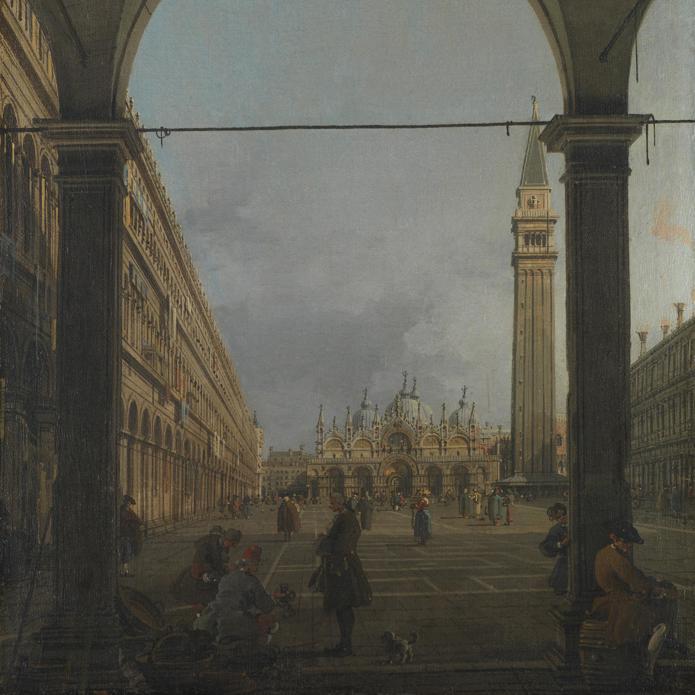Canaletto, 'Venice: The Piazza San Marco', about 1756
About the work
Overview
We see the Piazza San Marco from just inside the colonnade of the Procuratie Nuove, which housed the procurators (or caretakers) of San Marco. Although painting one of Venice’s most famous sights, Canaletto took liberties with the architecture to create a dramatic composition, enlarging the size of the archway and removing one of the pillars so we can see both the piazza and down the arcade.
In front of us, two men lean back against an archway, a dog sitting faithfully at their feet. Another, wearing a vivid green cloak and holding a cup and saucer, seems to be listening in on their conversation. Behind him is the famous coffee house, Caffè Florian – probably where his beverage comes from.
Canaletto experimented with a form of visual trickery, arranging the vertical lines of particular architectural features – the pillar of the arch and the column on its outer edge with the campanile (bell tower) beyond, for example – to create an unusual and interesting composition.
Key facts
Details
- Full title
- Venice: Piazza San Marco and the Colonnade of the Procuratie Nuove
- Artist
- Canaletto
- Artist dates
- 1697 - 1768
- Part of the series
- Two Views of Piazza San Marco
- Date made
- about 1756
- Medium and support
- oil on canvas
- Dimensions
- 46.4 × 38.1 cm
- Acquisition credit
- Salting Bequest, 1910
- Inventory number
- NG2516
- Location
- Room 33
- Collection
- Main Collection
- Previous owners
- Frame
- 18th-century Roman Frame
About this record
If you know more about this painting or have spotted an error, please contact us. Please note that exhibition histories are listed from 2009 onwards. Bibliographies may not be complete; more comprehensive information is available in the National Gallery Library.
Images
About the series: Two Views of Piazza San Marco

Overview
This captivating pair of view paintings – Piazza San Marco and Piazza San Marco and the Colonnade of the Procuratie – depict the Piazza San Marco, home to some of Venice’s most famous landmarks.
Canaletto painted these works during the late 1750s, shortly after his return to Venice from England. Because of their small scale and upright format they are somewhat unusual when compared to the artist’s earlier panoramic views, but his choice of composition was still innovative. In most of his paintings, we look across the Grand Canal or the lagoon that surrounds Venice. Here, Canaletto has experimented with viewpoints taken from within an architectural structure, for example an archway within a colonnade.
His mature phase prompted certain stylistic changes: he moved towards sombre colouring and darker tonality, and he tended to paint small canvases. This appealed to Venetian collectors and foreign tourists – smaller paintings would have been more affordable and easier to transport.

















